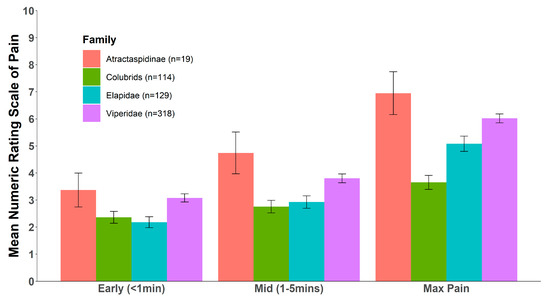“Fangs for the Memories? A Survey of Pain in Snakebite
Patients Does Not Support a Strong Role for Defense in the Evolution of Snake
Venom Composition”
Harry Ward-Smith, Kevin Arbuckle, Arno Naude, and Wolfgang Wuster
Toxins journal 2020
https://www.mdpi.com/2072-6651/12/3/201
A paper
recently published in the Toxins journal shows evidence that snake venom
evolved for prey capture and not as a defense mechanism. There are many
creatures that use venom or poison as a means to deter predators – bees, scorpions,
fish, and so on. In order to be an effective deterrent, the sting or bite has
to inflict enough pain quickly enough to leave the potential predator incapable
of continuing an attack. The authors of this article sought to examine the
level of pain induced by venomous snake bite, and the trajectory of that pain
through time. While some animals cause a distracting level of pain immediately,
such as the aforementioned Hymenoptera, this did not seem to be the case with
the majority of snake bites.
The
researchers collected information from people who had experienced snake bite
either with a captive animal or in the wild, gathering a total of 584 bite
reports. This encompassed 192 different snake species. Analysis of pain level
was accomplished by having respondents note their pain at <1min post bite,
1-5min post bite, and max pain experienced at any time. Interestingly, over 50%
of people never experienced a pain level that would be great enough to interfere
with normal activity. Only about 14% of people noted this high-level
distracting pain in the first 5 minutes post bite. Even more noteworthy, there
was a great variance between pain levels of different individuals bitten by the
same species. Research has shown that venom compositions of individuals amongst
the same species can be highly variable, which is further supported by differences
in envenomation experiences. This is an indication that venom has not evolved as
a predator defense.

The incidence of late pain is likely caused by the harmful effects of venom over time. The tissue damage and swelling associated with some venoms, as opposed to pain causing enzymes (such as MitTx in Micrurus), are the direct sources of pain in late stages of envenomation.
Phylogeny
seems to be the most likely indicator of early pain in snake bite. New world
pit vipers and Elapidae had the most painful early bite responses, though many
species have transitioned to no pain or late pain states. This loss of early
pain response for some venomous species is another indicator that predator
defense is not a likely explanation for the evolution of venom. Two interesting
exceptions may be the spitting cobras and some South American Micrurus, though
our native coral snake does not seem to share the pain-inducing toxin of its southern
counterparts.
Further
supporting the hypothesis that venom has evolved for prey capture is the loss
of venom in some species. Dasypeltis is part of a clade of rear-fanged
venomous snakes. While there are vestiges of a venom delivery system, it is being
lost through mutation, presumably because Dasypeltis feeds on bird eggs
and does not need venom for foraging. Other research has found that many
species possess a prey-specific venom toxicity, further supporting the prey-based
evolution of venoms.
While a
venomous bite may offer some protection against predators, either as an
individual deterrent or through social learning of predators, this seems to be
a secondary benefit. The authors mention the “life-dinner principle,” which posits
that “defense, where the snake is fighting for its life, should take precedence
over foraging efficiency, where a suboptimal strategy would merely result in
reduced energy intake.” This research provides an interesting counterpoint to
this principle in the strategy of venomous snakes.
P.S. if anyone is interested in some fun reading on venoms, and some very graphic stories of envenomations, check out Dr. Brian Grieg Fry's 'natural history memoir' - Venom Doc. Here's a free PDF to keep you entertained in your quarantine.
https://static1.squarespace.com/static/55a239e2e4b0b3a7ae106f25/t/5c85885b53450a49a40694d4/1552255122300/Venom+Doc.pdf
2 comments:
Fascinating! Do the authors address the potential that the experience of pain may differ in humans vs. potential predators of snakes?
They did mention it, but not delve into any details. Essentially, they theorized that generalized predators would have similar nociceptors, and therefore pain response, as humans. Obviously, there are some specialists adapted to eating venomous creatures, but the authors focused on generalists.
Post a Comment